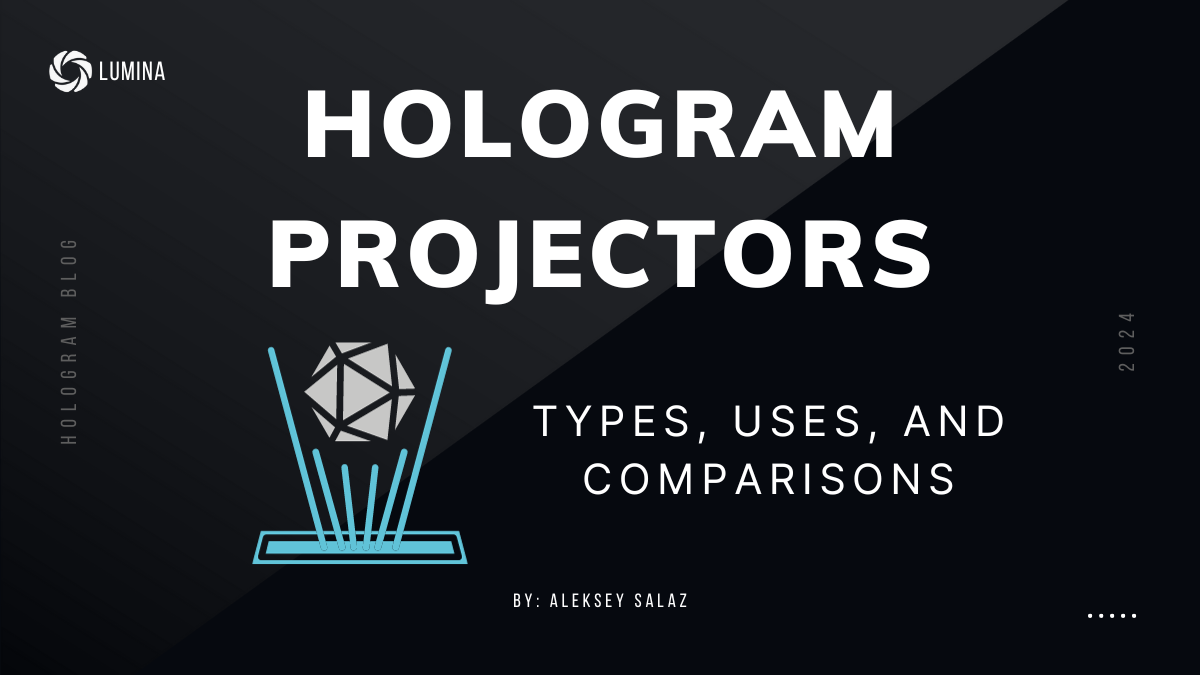Have you ever wondered what a hologram projector is? It's a device that brings images to life in three dimensions, floating in mid-air.
This technology is a step up from regular projectors that only display flat images. Hologram projectors use light in a special way to create these 3D effects, making images look real and almost touchable.
They're not just for show; they have practical uses in meetings, education, and entertainment.
Key Takeaways
- Understanding Hologram Projectors: A hologram projector is an advanced device that creates lifelike, three-dimensional images in the air, offering an interactive and immersive visual experience.
- Versatile Applications: These projectors have diverse uses across fields like education, advertising, and entertainment, enhancing engagement and presenting information in an innovative way.
- Considerations and Future Potential: While there are challenges like cost and technical complexity, the evolving technology of hologram projectors promises even more accessible and impactful applications in the future.
How Does a Hologram Projector Work?
The Science Behind Holography
At its core, the science of holography is all about light. It's a clever way of capturing and showing light patterns.
This process starts with understanding how light behaves. Normally, light spreads out in all directions. But in holography, lasers help control the light. They keep it focused and precise.
The magic happens when this laser light interacts with an object. Part of the light reflects off the object, and the rest continues its path.
When these two light parts meet again, they create a pattern. This pattern is unique, like a fingerprint for the light and the object. It's this pattern that a hologram projector captures and uses.
The projector doesn't just show a flat image. Instead, it recreates the light pattern in a way that tricks our eyes.
We see it as a three-dimensional image hanging in the air. It's like the object is right there, even though it's just light.
This is the basic science that makes hologram projectors not just fascinating but also a powerful tool in various fields.
Types of Hologram Projectors
When we delve into the types of hologram projectors, it's like opening a door to a world of varied and advanced technology. Generally, these projectors can be categorized based on their use and the method they employ to create holograms.
Reflection Hologram Projectors: These projectors use a reflective surface to display the hologram. They are well-suited for indoor environments and often used in galleries, museums, and educational settings.
Transmission Hologram Projectors: In contrast, transmission projectors work by allowing light to pass through a holographic image. This type is often more detailed and is commonly used in more sophisticated settings, like scientific research.
Interactive Hologram Projectors: These are the ones that take us a step into the future. Interactive projectors respond to human interaction, making them popular in advertising and entertainment industries. They can recognize gestures or movements, allowing for a dynamic experience.
Portable Hologram Projectors: With the rise of mobile technology, portable projectors have become increasingly popular. These are smaller, user-friendly, and can be used for personal entertainment or business presentations on the go.
Each type of hologram projector has its unique features and applications, making them suitable for different needs and settings. As technology advances, we're likely to see even more innovative types emerge in the market.
What is the Purpose of a Hologram Projector?
Enhancing Visual Presentations
One of the primary purposes of hologram projectors is to take visual presentations to the next level.
Imagine sitting in a meeting or a classroom where, instead of flat images on a screen, you're shown three-dimensional, floating visuals.
This technology makes presentations more engaging and interactive.
With hologram projectors, viewers get a lifelike experience. This is especially useful in scenarios where understanding the depth and details of an object is crucial.
For example, architectural designs and prototypes can be presented in a more realistic and tangible way, making it easier for viewers to grasp complex concepts.
This immersive experience is not just about wow-factor; it's about making information easier to understand and retain.
By presenting data and designs in 3D, hologram projectors help in conveying messages more effectively, leading to better communication and understanding in various fields.
Educational and Training Applications
Hologram projectors are revolutionizing how we learn and train. In educational settings, these devices bring subjects to life.
Imagine learning about the human body with 3D holographic organs floating in front of you.
It makes learning more interactive and memorable.
In training scenarios, such as medical or technical training, hologram projectors offer a safe and detailed environment.
Medical students can study human anatomy in 3D without the need for real cadavers.
Similarly, engineers can explore complex machinery from every angle, gaining a deeper understanding of their workings.
These applications are not just limited to professional training. They extend to schools and museums, making education a more engaging and immersive experience for students of all ages.
By providing a three-dimensional view of the world, hologram projectors are making learning more exciting and effective.
Advertising and Marketing Innovations
Hologram projectors are not just about education and entertainment; they're also transforming the advertising and marketing world.
Imagine walking past a store and seeing a 3D holographic display of the latest product.
It's eye-catching and memorable, making it an excellent tool for attracting potential customers.
These projectors offer a new way to showcase products. They can display items in 360 degrees, giving customers a detailed and realistic view.
This is especially beneficial for high-end products like jewelry, cars, or electronics, where detail and design are key selling points.
Moreover, hologram projectors provide a unique way for brands to stand out. In a world where grabbing customer attention is increasingly challenging, these projectors offer an innovative and effective solution.
They're not just displaying products; they're creating an experience that can lead to a lasting impression and, ultimately, customer loyalty.
Hologram Projector Disadvantages
High Cost and Accessibility
- Expensive Technology: Hologram projectors are costly, making them less accessible for individuals and small businesses. The advanced technology and materials needed for these devices contribute to their high price.
- Additional Setup Costs: Beyond the purchase price, setting up a hologram projector often involves extra expenses, such as specialized software and hardware, adding to the overall cost.
- Limited Accessibility: Operating and maintaining hologram projectors requires technical expertise. This limits their use to those with specific skills or training, hindering broader adoption across various sectors.
Technical Limitations and Challenges
- Limited Viewing Angles: Many hologram projectors have a restricted viewing angle. This means the holographic effect might not be visible from every angle, which can limit audience engagement.
- Resolution and Image Quality: The resolution of holographic images is often lower compared to traditional displays. This can impact the clarity and detail of the projected images, affecting the overall experience.
- Dependency on Environmental Conditions: Hologram projectors can be sensitive to light and environmental conditions. Bright light or direct sunlight can wash out holographic images, making them difficult to see and less effective.
- Complex Setup and Calibration: Setting up a hologram projector can be complex and time-consuming. Proper calibration is crucial for optimal performance, requiring technical know-how and sometimes professional assistance.
Content Creation and Complexity
- Challenges in Content Development: Creating content for hologram projectors is not straightforward. It requires specialized skills in 3D modeling and animation, which can be a significant hurdle for many creators.
- Time-Consuming Process: The process of developing holographic content is time-consuming. It involves detailed work to ensure that the 3D models look realistic and function properly when projected.
- Limited Availability of Ready-Made Content: There is a scarcity of pre-made holographic content available. This means users often have to create their content from scratch, adding to the effort and cost.
- Need for Custom Software: Often, specific software is required for creating and projecting holographic content. This software can be complex and may require additional learning and investment.
Wrapping Up
Hologram projectors, with their ability to create stunning 3D visuals, are undoubtedly a leap forward in display technology. They bring a new dimension to presentations, education, advertising, and entertainment.
While they come with their own set of challenges, like high costs, technical limitations, and content creation complexities, the potential they offer is immense.
As technology continues to advance, we can expect these projectors to become more accessible and user-friendly. The evolution of hologram projectors will likely address current drawbacks, making them an even more integral part of our daily lives and professional environments.
The journey of hologram projectors is just beginning, and it's one that's filled with exciting possibilities and opportunities for innovation.
Ready to Experience the Future?
Discover the cutting-edge world of 3D holographic displays with Lumina.
Whether for business, education, or personal entertainment, Lumina's range of hologram fans offers a dynamic and innovative way to bring your visuals to life.
Explore our collection today and transform your space with the magic of holography.
FAQs about Hologram Projectors
1. What is a hologram and what does it do?
A hologram is a three-dimensional image created with photographic projection. It appears to be a real, physical object but is actually made of light. Holograms are used to display objects or scenes in a lifelike way.
2. What is the difference between holographic and 3D projection?
Holographic projection creates 3D images that appear to float in space, visible without special glasses. 3D projection, on the other hand, usually requires glasses and projects images onto a flat surface, giving the illusion of depth.
3. What is the difference between a projector and a hologram?
A projector casts two-dimensional images onto a surface, while a hologram projector creates three-dimensional images that appear to float in mid-air, offering a more realistic and interactive visual experience.
4. How do hologram projectors work?
Hologram projectors use laser light to create 3D images. The light interacts with physical objects or digital data to produce a holographic image that appears to float in space.
5. Can hologram projectors display in color?
Yes, modern hologram projectors can display full-color images, making the holograms more realistic and vivid.
6. Are hologram projectors used in education?
Yes, they are increasingly used in educational settings to provide interactive and immersive learning experiences, especially in fields like anatomy, architecture, and engineering.
7. What are the main applications of hologram projectors?
Hologram projectors are used in various fields including education, advertising, entertainment, medical training, and product visualization.
8. How much do hologram projectors cost?
The cost of hologram projectors varies widely based on size, quality, and features. High-end models can be quite expensive, while simpler versions are more affordable.
9. Can hologram projectors be interactive?
Yes, some advanced hologram projectors offer interactive features, responding to gestures or movements, enhancing user engagement.
10. Are hologram projectors portable?
While traditional hologram projectors are typically stationary due to their complexity, there are portable models available for more flexible use.


